ASUS MATRIX – Offering finer levels of GPU control for everyone...
by Rajinder Gill on September 5, 2008 12:00 AM EST- Posted in
- Raja's Ramblings
While NVIDIA, ATI and manufacturers like EVGA offered proprietary software control of their graphics products over the years, manufacturer endorsed voltage adjustments have been missing for GPUs. In the past, third party programs like ATI Tool fulfilled this role for supported ATI cards, while NVIDIA users have been left to hard mod their cards with potentiometers or pencils or other things that go bump in the night – thus voiding the card's warranty. ASUS figured direct manipulation of GPU voltages would be a unique market opportunity for an ODM. So ASUS is introducing a new line of graphics cards featuring a new software tool; together these will be known as MATRIX. We think it will be a pleasant change to drop the need for two or three separate programs just to get granular level of control over a graphics card. We hope MATRIX offers just that when it is released this month.
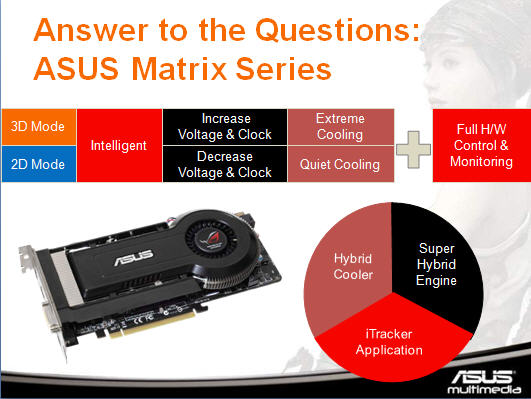
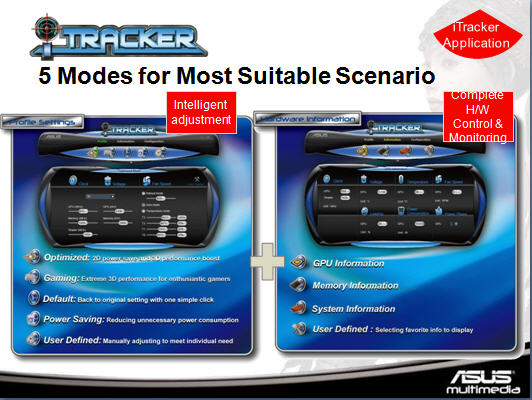
Like its peers, the MATRIX software utility allows adjustment of GPU, shader and memory clock speeds and also fan speed control profiles for specific scenarios. Although in this instance we see fan control being offered on a more comprehensive level.
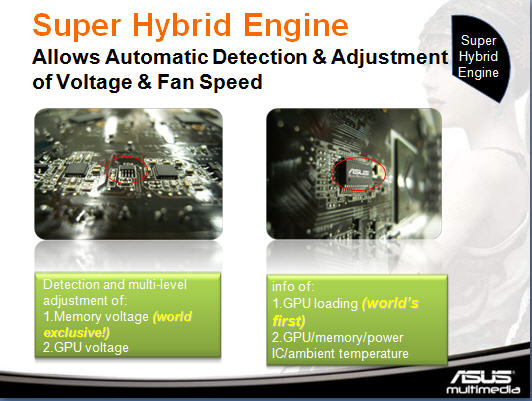
On the hardware side, MATRIX cards feature discrete controller ICs that can offer a very granular voltage adjustment scale with up to 80 programmable steps.
Naturally, the maximum level of voltage available is going to be limited by the capabilities of the pre-installed air-cooling system. It'd be foolish to allow a range that exceeds the potential of the supplied cooling system without some form of lock to prevent over-zealous users from succumbing to misadventure. Hence users with sub-zero cooling capabilities will still have to resort to hard voltage modifications to get their fix. It's no surprise that ASUS had to look beyond reference designs to provide sufficient cooling before even considering any kind of overvolting control.
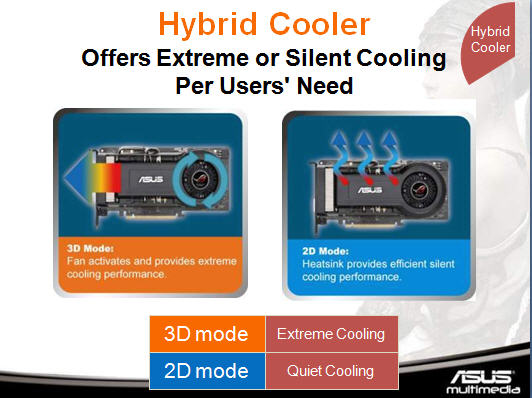
ASUS calls this the Hybrid cooler, the slides suggest a hefty enough heatsink that allows full fan redundancy in 2D mode (it'll obviously have a limit based upon ambient temps) while the fan can step-in and ramp up for demanding 3D situations. If ASUS can get the balance between temperature, performance, and noise right, a high performance uATX based gaming rig is not out of the question.
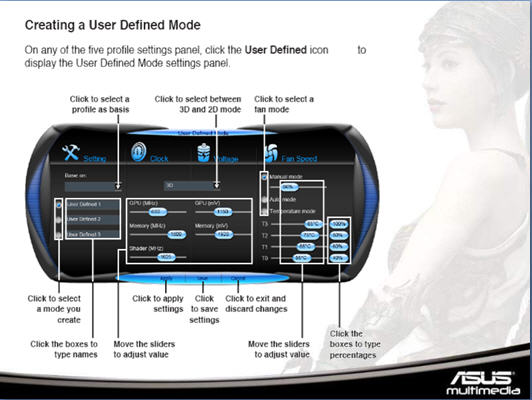
Fan control is nothing new to those of us familiar with ATITool and Riva Tuner, although the ASUS GUI seems to be far more intuitive at first glance than the readily available third party solutions.
So what are the claimed gains of combining all the above features into a single well executed software tool?
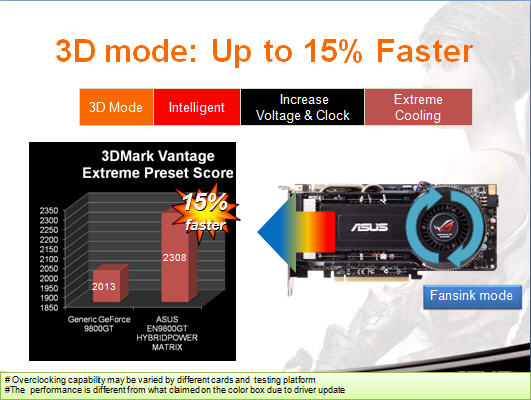
First off, ASUS is expecting the automatic overclock technology to improve certain benchmark scores up to 15% or possibly more depending on the card, driver, and application. While manual tuning will always result in the highest possible scores, it is nice to see a design that will take a card almost to its limits and then scale back almost instantly without any user involvement.

Downclocking in 2D mode has been a feature of video card drivers for some time. Intel's VRM 11.1 motherboards power delivery specification ushered in a range of new PWM controller ICs capable of switching off power phases when a CPU is idling. As a GPU power circuit works on the same principles, it's perfectly logical for companies to go ahead and use the power phase on/off manipulation capabilities of these controllers to also power graphics cards. Once again, the benefit of having a one-click GUI system with flexibility for user control pulls MATRIX ahead of the crowd.
What about price?
No doubt, the added features will add up to a quicker relief of currency in your wallet. Current pricing for a standard 9800GT 512M is around the $129 mark. GTX, GTX+, and 1GB cards are available from $169-$200 with current rebates. We think users would be willing to pay a small premium over stock and perhaps even pre-overclocked 512M cards for the extras, but ASUS will have to be near current prices to make MATRIX an attractive option on the 9800GT (first chipset design to be released). If it's close enough and all the features work as advertised, we are looking at a very serious new contender in the mid-range market.
As soon as we get our hands on review samples, we will put them through their paces in a variety of scenarios and report on exactly how well Matrix works. What we are seeing here is the next step in the evolution of video card design. Thanks to companies like ASUS, we've seen the death of the motherboard volt-mod for the most part. There's just really no need for them anymore - all of the voltages we could or would want to control are basically available in the BIOS now, ready for manipulation in just a few seconds. Only the most "hardcore" users even think of modifying their boards anymore via hardware or with custom BIOS routines. Now, with the help of ASUS' MATRIX technology we may finally see the same come to pass with video cards. Bravo.













17 Comments
View All Comments
thebeastie - Sunday, September 7, 2008 - link
Just like the GigaByte Extreme and MIS Platinum MB's HyBrid cooling is now synonymous with Water cooling with air fall back capability.I think Asus are distorting this meaning.
Where are Video cards with built on water cooling pipes? I don't thing gfx cards have come nearly far enough yet.
jmurbank - Monday, September 8, 2008 - link
I assuming you are explaining about heat pipes. Yes they act like water cooling, but they act on the concepts of evaporative cooling that contains no moving parts. Combining heat pipes with passive cooling increases efficiency of the heat sink with out the awkward and bulkiness setup of water cooling.Water cooling is more of a mod than a neccessary for video cards and other computer components. With use of heat sinks and heat pipes water cooling is not needed. IMHO, water cooling is not as efficient as air cooling on terms of area and price.
ASUS is not distorting the term hybrid. ASUS wants to suit two kinds of people. One is extreme gamers and others silent PC/efficiency. Their circuitry suits both areas while in the past users have to give up either area for want they want most.
FYI, it is Hybrid not Hybird, dumb ass.
Kobaljov - Saturday, September 6, 2008 - link
Maybe it's not just a coincidence that the "HybridPower" is a part of the card's name, because the Nvidia same named function works similar: silent in 2D with lower power consumption using only the motherboard's IGP, and in 3D works on full power with active cooling using the external GPU. So for a function like this there is alternate way when using Nvidia cards, but on AMD/ATI side, only the 4850 Matrix version will be available (yet).The card's price will be a serious question, because the MSI's 9600 GT Hybrid Freezer are priced too high (more than double of the cheapest 9600 GT's, here in Hungary), and I saw (at only one place) the price of the 9600 GT Matrix too, and it was more than 50% higher than the cheapest one (nearly as much as the cheapest 4850).
Arbie - Saturday, September 6, 2008 - link
Don't be optimistic. Asus has good BIOS programmers but almost everything they produce as a GUI has major problems. Read the forums on Asus SmartDoctor and AISuite (or whatever it's called). I got all those with my Rampage mobo and Asus 4850 graphics board and - ignoring all advice to the contrary - installed them. Everyone was right: the few parts that did work were useless. In fact the most useful Asus program was one they didn't include - PC Probe II. That did work, and pretty well too, IF you can find it. But it's the exception that proves the rule. I don't have much any hope for this even more complex new idea.Arbie
MrSpadge - Saturday, September 6, 2008 - link
I wholeheartly agree with Arbie! Good Anandtech guys, if you speak with Asus about this, please tell them that they've got something great there - but to make it a success they have to do much better than most of their utilities so far.I want a tool which offers at least as much functionality for the power user as ATI Tray tool and which brings GPU voltage control for NV cards (F*ck overvolting - these GPU are hot enough, we need the ability to undervolt). Switching between profiles with a maximum of 2 clicks via a tray icon has to be possible as well as automatic switching, i.e. upon launch / exit of an app. And to round the package a non-power user has to be able to make good use of the presets. These are the basics which just have to work.
If they work properly we could take things a little further. There are 2 major problems which I find untouched since years:
- why always try to maximize fps? I'd so much prefer to set a target frame rate (and I choose if it's 30 or 300 fps) and if the GPU is fast enough in older games it could just throttle down a bit and save power and prolong its life and the life of my ears. I suspect this would require working together with NV though.
- GP-GPU: thanks to CUDA NV cards can now run folding@home and GPU-Grid under BOINC. However, these GPUs and their cooling systems are not build for such loads. Let NV say their chips are fine running at 70 or 90°C 24/7 - they're not.
What I have in mind here: either have a manufacturer spec or have this little Asus software run a test on your GPU (either at a specified temperature or a fixed fan speed, or both) which voltage it requires for which clock speed. With such a profile you could dynamically adjust clock and voltage according to
* needed performance in 3D, see above
* maximum allowed temperature and fan speed (i.e. crunching 24/7)
while always remaining in an efficient operating regime, i.e. not giving the GPU more voltage than it actually needs. This saves power, enables quieter systems and prolongs the life span of the cards.
On the software side this could be as easy as that: you open the tool, select "economic mode", it asks you for the maximum fan speed and maximum temperature (while suggesting reasonable presets). You have a slider for the fan speed where you can hear the noise live. When you click "apply" the tool asks you, if it should detect the optimal voltages for your specific GPU (would need proper safety margins here) or just use the values supplied by NV. Done is your 24/7 setup. There should also be an advanced option to set the voltages yourself ;) And there's of course the game profile, where you allow higher fan speeds and temperatures because this load is run for shorter times.
This idea may not be too revolutionary, because it's really just cool and quiet / speed step for GPUs .. but I had this idea since a looong time ;) And with the current move to "green" there might finally be an opportunity to make GPUs run efficiently!
(BTW: and why is the example 9800GT still using 30W in idle mode with the improvements?! It turns down voltage and clock speed and power mixer should switch unused parts of the chip off.. what's using so much power there?!)
MrS
loopandjump - Friday, September 5, 2008 - link
I'll be awesome if this works in linux as well!!jmurbank - Monday, September 8, 2008 - link
I agree, but the only way they can easily support both Windows and Linux is using Qt libraries to ease GUI design. Driver design will be a different story.bjacobson - Friday, September 5, 2008 - link
I'm confused how the passive is supposed to work. From the demonstration the heat "rises by convection".But the graphics card is oriented with the heatsink down in most mini-tower computers.
Griswold - Saturday, September 6, 2008 - link
The primary target audience of this doesnt care or know about thermodynamics.VooDooAddict - Friday, September 5, 2008 - link
My fear with something like this is special drivers. Anytime a card needs special drivers they tend to lag behind... they also become unsupported much quicker.